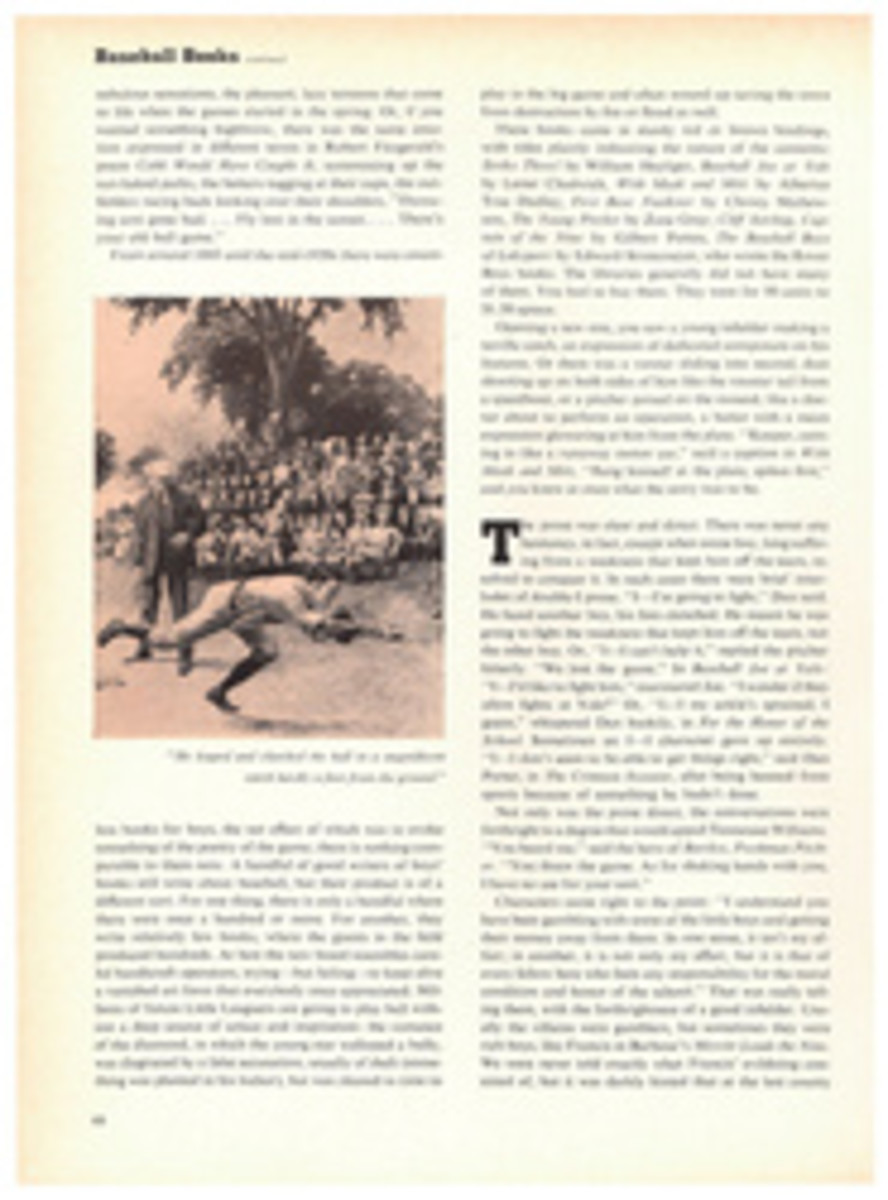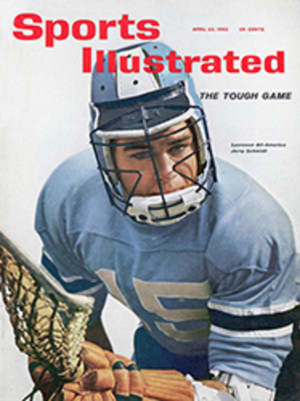
SCORECARD
THE PROOF, PLEASE
Championship Sports Inc., the promoters, expect Floyd Patterson to defend his title against Sonny Listen in New York in September. It should be one of the most exciting fights in years and will make lots of money for all concerned. We deplore only the" assumption that the fight can take place before it has been demonstrated—beyond any question—that Liston is free of hoodlum control.
LUCAS TO NEW YORK?
Jerry Lucas, Ohio State's 6-foot-7 All-America who has maintained for a year that he is not going to play professional basketball, is the subject of some of the most intense negotiations ever conducted over an untried rookie. While the Cincinnati Royals, who own the draft rights to Lucas in the NBA, and the Cleveland Pipers of the rival ABL are each straining their bankbooks to woo him, Lucas has dropped out of Ohio State and gone on an extensive lecture tour in the Midwest. It is his plan to use the proceeds from his lectures to return to school with his wife next fall, and eventually work toward a master's degree.
But the latest and least-known development in the Lucas chase could make Jerry think twice. The New York Knicks carefully drafted Paul Hogue, a local hero in Cincinnati because he led the university there to two national championships. Now they are considering offering Hogue and a bundle of cash to the far less prosperous Royals for the draft rights to Lucas. The theory is that the Knicks, with all those high-priced Madison Square Garden seats available, can afford to give Lucas a huge offer he could not refuse, whereas the Royals would be unable to go high enough to get Lucas out of the classrooms.
THE INSIDE TRACK
•Talk is that former Dallas Cowboy Quarterback Don Heinrich, now a New York Giants' coach, is itching to get back onto the playing field and the West Coast. He may jump to Vancouver in the Canadian League or to San Diego in the American Football League.
•Quarterback Bobby Layne will probably report to the Pittsburgh Steeler training camp this summer but it's rumored he'll retire before the season begins. The Steelers plan to play Ed Brown as top quarterback next fall—otherwise why would they have traded their No. 1 draft choice to the Chicago Bears for him? Layne will hardly agree to play second fiddle at this stage of his career. Persistent reports that Layne's arm is dead seemed confirmed by his late-season performance last fall.
•Basketball's National Invitation Tournament, held every March in New York's Madison Square Garden, may be seriously hurt by the new National Catholic College Tournament, which will be held next year in Louisville in March. The NIT in recent years has relied heavily on Catholic college teams.
OPENING DAZE
Crowds were generally sparse the first week as big-league baseball opened its season, but first-ball throwers were out in record numbers. The list included two presidents (Kennedy, of the U.S., and Harridge, formerly of the American League), three governors, 10 mayors (mayors are very large in the first-ball-throwing game), one senator, one representative, one judge, two baseball players (one a Hall of Fame star, the other a 17-year-old minor leaguer), two baseball club officials, one sports editor, two ladies and two little girls. Here's the breakdown:
Washington: President Kennedy.
Cincinnati: Mayor Walton Bachrach.
New York: Mrs. Babe Ruth (Yankees); Mayor Robert Wagner (Mets).
Chicago: Will Harridge, ex-president of the American League (White Sox); Bob Lewis, Cubs' longtime traveling secretary (Cubs).
St. Louis: Mayor Raymond Tucker.
Milwaukee: Susan Perry, 9, and Diane Bauch, 7, the "Milwaukee County Easter Seal Children for 1962."
Boston: Governor John Volpe.
Houston: Judge Bill Elliot pitched the first ball, Representative Bob Casey batted and Mayor Lewis Cutrer, behind plate in catcher's gear, caught it.
San Francisco: Mayor George Christopher.
Kansas City: Sports Editor Ernest Mehl pitched from mound to K.C. Owner Charles Finley, behind plate, symbolizing end of their bitter feud.
Philadelphia: Mayor James H.Tate.
Los Angeles: Mrs. Walter O'Malley (Dodgers); Farm Team Pitcher Angel Macias, former star of the Monterrey, Mexico Little League team, who threw to Mayor Sam Yorty (Angels).
Minnesota: Governor Elmer L. Anderson.
Cleveland: Mayor Anthony J. Celebrezze pitched from mound to Senator Frank Lausche. First pitch went over Lausche's head but he hit next one toward left field.
Pittsburgh: Hall of Famer Harold (Pie) Traynor.
Baltimore: Mayor J. Harold Grady.
Detroit: Mayor Jerome P. Cavanagh and Governor John B. Swainson showed up for joint act. Crowd booed. Because of bad weather, act was called off. Crowd cheered.
SPACE AGE FIELDER
Strange are the ways of notoriety, and once a man gets it he's apt to think it has a future. Sal Durante, who caught Roger Maris' 61st home run ball last fall, then was paid $5,000 for the ball by a San Francisco restaurateur and got married on the proceeds, was planning to be an attraction at the Seattle World's Fair, where he was to try to catch a ball tossed off the 660-foot Space Needle for a $1,000 fee.
Durante told the Seattle Times that he would soon go into spring training. His site: a 374-foot-high gas tank on New York's Coney Island, from which a ball will be dropped. Sal intended to wear a catcher's mask. Dr. Kenneth C. Clark, professor of physics at the University of Washington, estimated that the baseball's journey from the top of the Space Needle to Sal's mitt would have taken 6.1 seconds and that the ball would be doing about 130 mph at impact, roughly half a hundred miles an hour more than Maris' ball traveled. Dr. Clark's velocity count made the authorities think twice, and the stunt was called off. "I think," said Clark, "a set of teeth is worth much more than $1,000."
PUT THE MONEY IN THE POT
CBS bid a record high of $5.1 million a year for the right to televise college football games for the next two seasons, a delightful figure to money-conscious minds in the big schools that appear fairly regularly on fall football telecasts. (ABC, which aired the games last season, paid only $3,125,000 for that privilege.) But then the NCAA television committee made a gesture to smaller schools that never make TV but whose gate receipts are hurt by the televised games. The committee recommended that 200 of these schools be granted $5,000 each from the bubbling TV pot. This did not please the big schools. Like Al Capp's General Bullmoose, they have a simple, small ambition—to get all the money in the world. The Big Ten in particular is supposed to be chafing under the NCAA's paternal hand and is said to be contemplating talks with other money-minded major conferences about the sad situation.
OF FLIES AND FISH
The movement to allow only fly-fishing in certain areas has reached New Mexico, which joined about 18 other states when it recently set aside some trout waters for nothing but fly-fishing (actually, flies and artificial lures). Angry bait fishermen reacted predictably: "I paid $3.50 for a license and I want to fish anywhere and any way I want to!" Bill Humphries, an area supervisor for the state, gave cogent arguments for the restriction: "It was apparent that our streams and trout could not stand the increasing fishing pressure. Trout stocking helps, but the state [was] planting hand-fed trout in streams and lakes where fishermen stood shoulder to shoulder catching them before their backs were covered with water. Other states and countries had this problem years ago. New Zealand for decades now has had fly-fishing only, with a 14-inch minimum on all trout. Needless to say, their fishing is fabulous. Maine has more than 150 miles of trout streams where bait fishing is prohibited.
"The strongest argument against this holds that restricted fishing will help only the minority group of advanced or 'pure' fishermen, those who spent years learning their art and who own very expensive equipment. But fly-fishing can be very inexpensive, and it's easy and fun to learn. And most bait fishermen will admit that fly-fishing is a more sportsmanlike way to take trout. We have felt an increasing need through the years to stress the sporting or esthetic value of fishing rather than the quantity or 'meat' value that so many fishermen seem to think is the most important thing. We feel that most fishermen can experience as much, or more, satisfaction in catching one or two big ones as they can from taking a bag limit of six-or eight-inchers."
SERVICE
At the Arnold Palmer press conference in the Augusta National clubhouse after the Masters, a news photographer removed his shoes and climbed up on a table to get a better angle. After several minutes of shooting pictures, he climbed down and discovered that a porter had picked up his shoes and given them a glistening shine.
SAPERSTEIN'S FOLLY
The American Basketball League tried hard all season to put itself in the category of a major professional league and then just about nullified the few good notices it had by the way it conducted its championship playoff. For one thing, the third game of the final series between the Kansas City Steers and the Cleveland Pipers was started after 11 p.m. so that a game between the Harlem Globetrotters and the so-called U.S. Stars could be played first.
Then, with the teams tied in victories after the first four games—two in Cleveland and two in Kansas City—there was a mean wrangle over where the fifth and final game should be played. Abe Saperstein, commissioner of the league, owner of the Globetrotters and president of the Chicago entry in the ABL, assured the Cleveland Pipers, or so the Pipers thought, that the fifth game would be played either in Cleveland or on a neutral court.
But shortly before the fourth game Saperstein informed both team presidents that any fifth game would be played the next night, Sunday, at Rockhurst College in Kansas City in a gymnasium seating approximately 1,500 people. George Steinbrenner, Cleveland president, declared his team wouldn't show up for a Sunday night game in Kansas City. And Saperstein said he was going to see his lawyer about that. Then the Steers, while changing planes in Chicago on Sunday, were offered the option of playing the final game in St. Louis on April 14 as part of a doubleheader with the Globetrotters and U.S. Stars, or of just sharing the championship with Cleveland. The Steers turned down both offers. Saperstein then announced the playoff would occur Monday night in the Rockhurst College gym. The Cleveland players voted to go to Kansas City, and they won the championship, which by that time had diminished to a minor honor.
QUEEN'S MOVE
Chess fans and admirers of chic will be glad to learn that Lisa Lane, the world's prettiest chessplayer, is making a comeback. Beginning Sunday she defends her U.S. women's title in a tournament to be played at three New York City chess clubs. In England last January, Lisa fled the Hastings tournament, bowed out of one in The Netherlands and ruefully renounced chess. She told the press she was homesick and unable to concentrate. But as valid a reason might have been her failure to do as well as expected in the Women's Candidates Tournament in Yugoslavia, whose winner would challenge world champion Elizaveta Bykova of the U.S.S.R. Lisa tied for 12th out of 17 as Russian ladies took the first three places. Lisa drew with the winner, Nona Gaprindasvili, but frittered away other games through impatience and the pressure of the clock.
Challengers for Lisa's title include three ex-champions and a teen-age prodigy—14-year-old Kate Sillars. Though it's the strongest field ever assembled for this championship, Lisa, who has been studying openings with an expert, is not worried. "The main thing I learned in Yugoslavia," she says, "is that I hate to lose."
ILLUSTRATION

